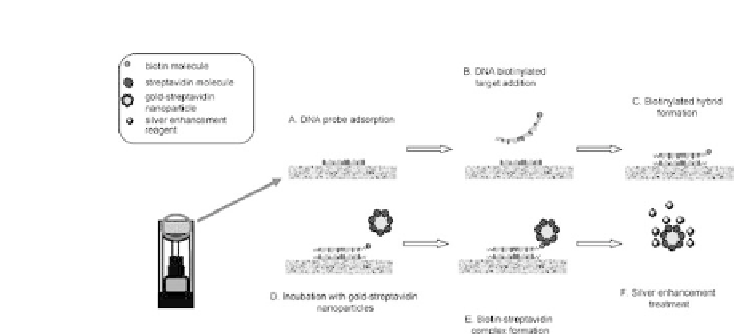Biology Reference
In-Depth Information
Figure 4.13.
Schematic illustration of the experimental procedure fol-
lowed to obtain DNA hybridization sensors based on stretavidin-modified
Au-NPs and silver enhanced detection [78] (reprinted with permission of
Elsevier). See also ColorInsert.
digoxigeninantibody(anti-DIG)frommouseabletospecificallybind
the digoxigenin-modified end of the amplicon. A secondary anti-
mouse IgG labeled with Au-NPs, able to interact with the anti-
DIG, was then added for signal amplification. A silver enhancement
treatment was carried out by depositing onto the electrode surface
20 mL of a solution obtained by the combination of equal volumes
of enhancer and initiator, and allowing 7 min for the reaction to
proceed. The amplified signal was around 30% higher than the
signalobtainedwithoutamplification.
ElectrooxidationofhydrazinedoesnotoccuronDNA-conjugated
Au-NPs, although it does on bare Au-NPs. However, a chemical
treatment with NaBH
4
significantly enhances the electrocatalytic
activity of DNA-conjugated Au-NPs allowing a high signal current
to be obtained for compounds such as H
2
O
2
, formic acid, glucose,
or hydrazine [79, 80]. Figure 4.14 shows a schematic view of the
electrochemicalDNAdetectionapproachusingtheNaBH
4
enhanced
electrocatalyticactivityofAu-NPs.Thechemicaltreatmentproduces
the adsorption/absorption of a large amount of hydrogen species
on/into Au-NPs, thereby forming an enhanced activity state. This
enhancementprocessmayprovideveryfastelectron-transferkinet-
ics for hydrazine electrooxidation on Au-NP. A high signal current
was obtained at 0.7 V, whereas the low intrinsic electrocatalytic








